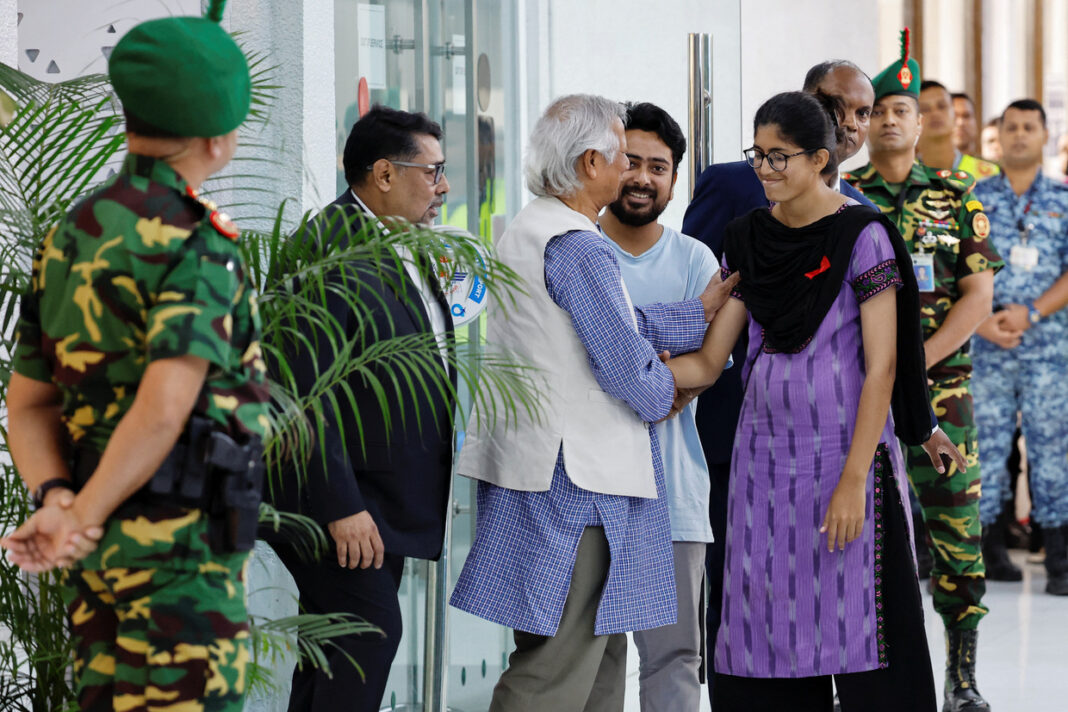With Sheik Hasina’s resignation, students have looked towards Muhammad Yunus in the hope of calming and reconstructing a more democratic Bangladesh.
The 5th of June can be considered the start to the end of Sheikh Hasina’s autocratic rule. Students have occupied the streets of Dhaka following the reintroduction of a 30% quota that reserves the most valuable jobs in the country to the families of war veterans, affiliated with the current leading political party, the Awami League. Bangladesh’s current situation has been critical, facing high unemployment, especially among its younger generations.
Daughter of the iconic Sheik Mujibur Rahman, a Bangladeshi politician at the centre of the country’s independence from India, Hasina first came to office in 1996. She was shortly replaced in 2001 but made her return to office in 2009, winning four elections and maintaining her position for 15 consecutive years. The last elections took place in January and saw the Awami League, the biggest party in Bangladesh, secure 223 seats of the 299 in parliament. Many considered the elections as rigged; opposing parties were restricted from participating in the elections. Sheikh Hasina’s regime has been increasingly resembling a tyranny.
The government’s response to the protests has been inevitably unrelenting. The majority of the fault has been put on Jamaat-e-Islami, the most important opposition party, and the students. The month of July saw the imposition of a strict curfew with military patrol. Furthermore, the internet was also cut down to prevent communication and the spread of images on social media. Only to be restored after a week. Lastly, mass arrests have been brought forward with approximately more than 10,000 being detained and protest leaders being taken away forcibly. Overall, more than 7000 people were injured and 300 have lost their lives.
Despite the quota being lowered significantly to 5% and the initial objective being reached, protesters revised their demands. Following the hundreds of casualties and the violence, protesters now demanded the immediate resignation of Sheikh Hasina. Their wishes were met as the prime minister resigned on August 5th after being fronted with an ultimatum. Hasina fled the country, seeking refuge in India. Consequently, the parliament was dissolved.
Muhammad Yunus
In the search for a new leader the people of Bangladesh looked towards Muhammad Yunus. Starting his journey at Dhaka University, he proceeded to get his Ph.D. in economics at Vanderbilt. Yunus always had a certain sense of goodness and altruism. Some of his past occupations include serving in the Advisory Council for Sustainable Economic Development, the Global Commission of Women’s Health, and the UN Expert Group on Women and Finance. However, the 84-year-old economist’s most important achievement has been winning a Nobel Peace Prize in 2006 following the success of Grameen Bank. Founded in 1983, the bank aimed at providing loans to small entrepreneurs without requiring any conditions to be met. This system guaranteed finances to millions of people, helping them out of poverty and inspiring other microcredit projects worldwide.
Despite his benevolent career, Muhammad Yunus has been in the cross hairs of Sheikh Hasina for some time. Their rivalry began with the creation of the political party Nagorik Shakti, or “Citizens’ Power” in 2007 by Yunus. As of June of this year, the now-new interim leader had been accused of embezzling 2 million dollars from his telecoms company’s workers’ welfare fund. Additionally, Yunus was sentenced to six months in prison for violations of labour law. Although he is not in prison after securing bail in that case, Yunus continued facing more than 100 cases regarding the violations and graft accusations. He and his supporters believe these allegations were politically motivated. Luckily, with the appointment as leader, all charges have been dropped.
Given the political turmoil, Bangladesh has also suffered significant economic disruption. It is estimated that approximately 10 billion dollars have been lost as a result of the protests and curfews. Much work will have to be done for Bangladesh to become a more peaceful, prosperous and democratic state.
Daughter of the iconic Sheik Mujibur Rahman, a Bangladeshi politician at the centre of the country’s independence from India, Hasina first came to office in 1996. She was shortly replaced in 2001 but made her return to office in 2009, winning four elections and maintaining her position for 15 consecutive years. The last elections took place in January and saw the Awami League, the biggest party in Bangladesh, secure 223 seats of the 299 in parliament. Many considered the elections as rigged; opposing parties were restricted from participating in the elections. Sheikh Hasina’s regime has been increasingly resembling a tyranny.




